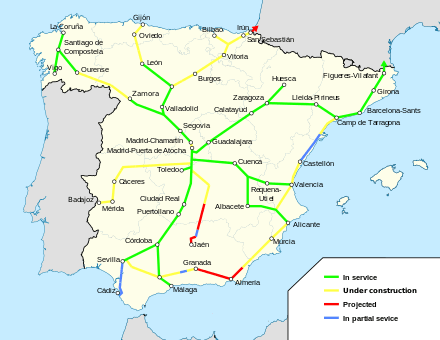Madrid–Málaga high-speed rail line

| Nuevo Acceso Ferroviario a Andalucía | ||||||||||||||||||||||||||||||||||||||||||||||||||||||||||||||||||||||||||||||||||||||||||||||||||||||||||||||||||||||||||||||||||||||||||||||||||||||||||||||||||||||||||||||||||||||||||||||||||||||||||||||||||||||||||||||||||||||||||||||||||||||||||||||||||||||||||||
|---|---|---|---|---|---|---|---|---|---|---|---|---|---|---|---|---|---|---|---|---|---|---|---|---|---|---|---|---|---|---|---|---|---|---|---|---|---|---|---|---|---|---|---|---|---|---|---|---|---|---|---|---|---|---|---|---|---|---|---|---|---|---|---|---|---|---|---|---|---|---|---|---|---|---|---|---|---|---|---|---|---|---|---|---|---|---|---|---|---|---|---|---|---|---|---|---|---|---|---|---|---|---|---|---|---|---|---|---|---|---|---|---|---|---|---|---|---|---|---|---|---|---|---|---|---|---|---|---|---|---|---|---|---|---|---|---|---|---|---|---|---|---|---|---|---|---|---|---|---|---|---|---|---|---|---|---|---|---|---|---|---|---|---|---|---|---|---|---|---|---|---|---|---|---|---|---|---|---|---|---|---|---|---|---|---|---|---|---|---|---|---|---|---|---|---|---|---|---|---|---|---|---|---|---|---|---|---|---|---|---|---|---|---|---|---|---|---|---|---|---|---|---|---|---|---|---|---|---|---|---|---|---|---|---|---|---|---|---|---|---|---|---|---|---|---|---|---|---|---|---|---|---|---|---|---|---|---|---|---|---|---|---|---|---|---|---|---|---|
Legend
| ||||||||||||||||||||||||||||||||||||||||||||||||||||||||||||||||||||||||||||||||||||||||||||||||||||||||||||||||||||||||||||||||||||||||||||||||||||||||||||||||||||||||||||||||||||||||||||||||||||||||||||||||||||||||||||||||||||||||||||||||||||||||||||||||||||||||||||
The Madrid–Málaga high-speed rail line is a standard gauge High-speed rail line of 512 km in length that links the city of Madrid with the city of Málaga in Spain. The line was inaugurated on 24 December 2007. At the time the service opened, Renfe Operadora was running 22 trains daily between Madrid and Málaga.
History
The first high-speed rail line in Spain was opened in 1992 when Madrid–Seville high-speed rail line was inaugurated as a part of the NAFA project (Nuevo Acceso Ferroviario a Andalucía, New Rail Access to Andalusia). In January 1993 the Talgo 200 Madrid–Málaga service began, using AVE lines as far as Córdoba and then Spanish-gauge conventional track to reach Málaga. The new high-speed section from Córdoba to Málaga, which is considered as a part of the New Rail Access to Andalusia, was projected in 1999 and integrated into the PEIT (Strategic Infrastructure Plan of the Ministry of Development, 2005-2020) with an estimated investment of €2.1 billion. Construction and operation were entrusted to Adif. The first 100 km of the new section between Córdoba and Antequera-Santa Ana was put in service on 16 December 2006. The line was completed on 23 December 2007 reaching the city of Málaga and the new station Málaga-María Zambrano.[1]
Line
The line is built to standard gauge supporting compatibility with neighbouring countries' rail systems and is designed for speeds of 300 km/h (186 mph). It connects the cities of Madrid, Córdoba and Málaga, and also includes stops at Puente Genil and Antequera in Andalusia, Spain that are served by the AVANT service. For the part between Madrid and Córdoba the line shares a common section with the Madrid–Seville high-speed rail line inaugurated in 1992. Outside Córdoba a 155 km in length spur railway branches off towards Málaga (the total distance between Córdoba and Málaga on the line is 170 km[2]).
Route
The stations along the line are Madrid Atocha railway station, Córdoba Central, Puente Genil-Herrera, Antequera-Santa Ana and Málaga-María Zambrano.
The line runs along a double track section in the few kilometres after Córdoba Central and later becomes quadruple track. Eventually, just outside a town called Los Mochos (a few kilometres east-north-east of Almodóvar del Río), the Seville and Málaga branches become separate.[3] The line takes a different route to the existing slower single-track line, but starts to run parallel to it between the towns of Doñana and Santa Rosalia Maqueda,[4] running alongside it for the rest of the journey to Málaga-María Zambrano station.
The section between Córdoba and Málaga runs through precipitous terrain in the Sierra Nevada and several viaducts and tunnels were necessary to complete the connections, including the Guadalhorce viaduct (574m), the Abdalajís Tunnel (the 3rd longest in Spain after the Guadarrama and Pajares tunnels at 8970m in the Cordillera Bética), the Arroyo de las Piedras viaduct (1208m long and 93.4m high, making it the highest viaduct along the line), the Arroyo del Espinazo and Jévar viaducts (the longest viaduct along the line when the two are considered together) and the Álora, Espartal, Tevilla, Gibralmora and Cártama tunnels that exist in a long chain.[5] The precipitous terrain is one possible reason why the Córdoba-Seville section was opened in 1992, but the Córdoba-Málaga section wasn't opened until December 2007.
Services
The AVE service (using the AVE Class 102) offers Madrid-Málaga journey times of 2 hours and 20 minutes with direct services.[1] The average speed of 220 km/h for this journey is not particularly high (the fastest Madrid-Barcelona journey is 2 hours and 30 minutes over 621 km, giving an average speed of 257 km/h): - trains are restricted to 200 km/h in the Sierra Morena (here, the curvature drops as low as 2300m,[1] meaning the maximum safe speed without tilting technology is approximately 226 km/h, as a curvature of at least 1800m is needed for 200 km/h and 7200m for 400 km/h ). The trains also slow down to 160 km/h for the Abdalajís and Gobantes tunnels, even though the tunnel radii are high enough to support 300 km/h.[1]
Direct Barcelona–Málaga AVE services are also offered by combining the Madrid-Málaga line and Madrid–Barcelona high-speed rail line on the same route. S-112 (Pato, max speed 330 km/h or 205 mph) trains are used for these services and cover the distance between Barcelona and Málaga in 5 hours and 50 minutes without making a stop in Madrid but with additional intermediate stops at Camp de Tarragona, Lleida Pirineus and Zaragoza-Delicias.
The AVANT services transport passengers directly from Seville to Málaga and vice versa, with intermediate stops at Puente Genil-Herrera and Antequera-Santa Ana stations between Córdoba and Málaga.
See also
- High-speed rail in Spain
- Madrid–Seville high-speed rail line
- Madrid–Barcelona high-speed rail line
- AVE Class 103
- AVE
- Córdoba, Spain
- Málaga
References
- 1 2 3 4 "Infraestructuras y Estaciones. Líneas de Alta Velocidad". Adif. Retrieved 27 November 2015.
- ↑ http://www.descubrelaaltavelocidad.net/default_en.aspx
- ↑ Google Maps
- ↑ Google Maps
- ↑ The northern portal of the Álora Tunnel can be seen on Google Maps, as can the southern portal of the Cártama Tunnel here.
External links
- "AVE at the RENFE" (in Spanish).
- Los Aves de Renfe "acortan distancias" entre Málaga y Madrid on YouTube (Spanish)
- AVE High Speed Train Malaga To Madrid on YouTube
